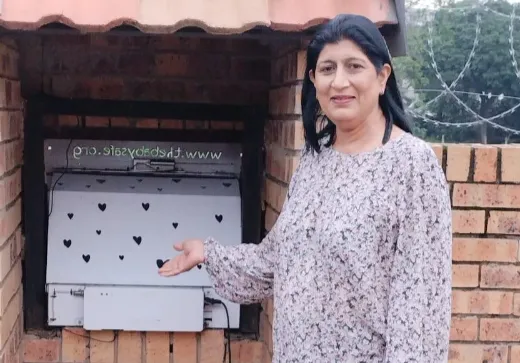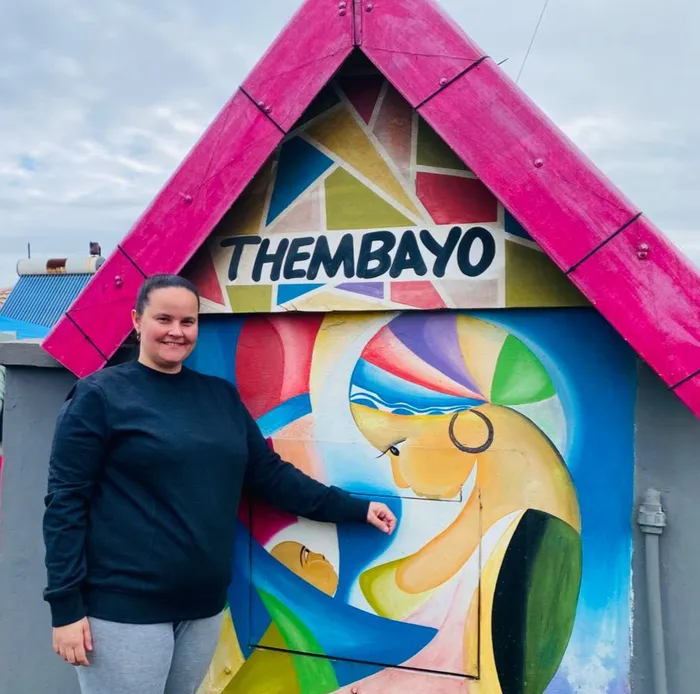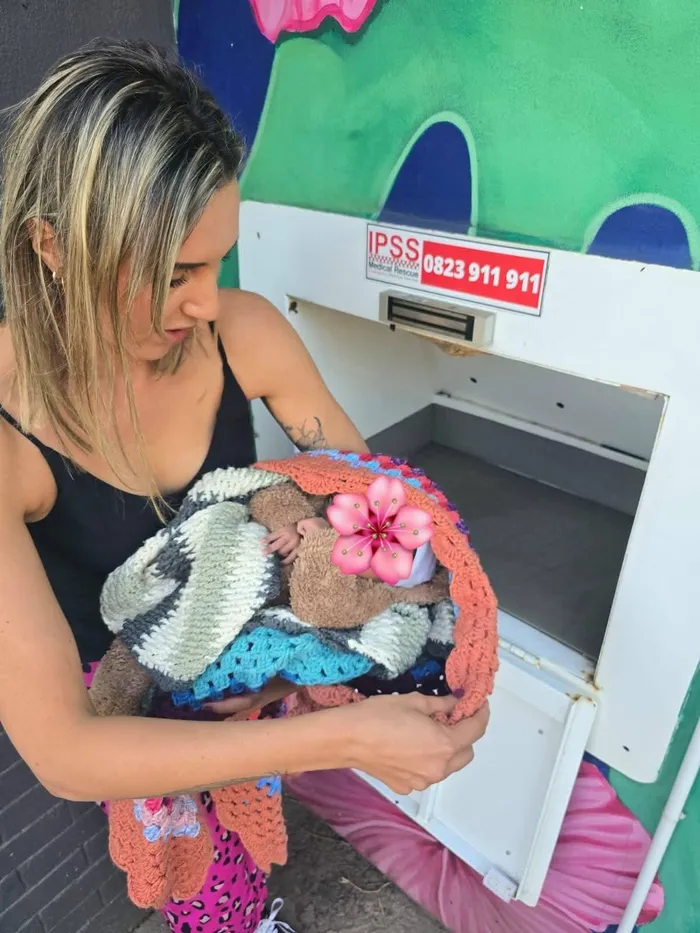Proposed Children's Act amendment sparks backlash over baby saver classification
'Baby savers save lives'

Aroona Chetty, the director of Phoenix Child Welfare, at the baby saver box, which is called the Valliamma Cradle of Love, in Phoenix.
Image: SUPPLIED
THE proposed amendment to the Children's Act that would classify babies placed in 'baby savers' as abandoned children has sparked fierce opposition from child welfare organisations who fear it would lead to more unsafe abandonments and criminalise desperate mothers.
The national government recently gazetted a draft Children's Amendment Bill 2025, which seeks to, among other things, amend Section 1 of Children’s Act 2005 in respect of what is considered to be an abandoned child.
According to the proposed amendment, it seeks to include “a child relinquished or placed in a baby box” as part of the definition of an abandoned child.
A baby saver is a box-like structure in the wall of a place of safety such as a child welfare organisation, children’s home or religious institution such as a church.
Once a baby is placed inside the box an alarm is triggered that alerts a member of staff that a baby has arrived. The baby is then collected and attended to by the relevant authorities.
Nokuzola Sisisi Tolashe, the Minister of Social Development has since called on the public to provide written comments on the Bill by October 25, 2025.
REACTION:
Aroona Chetty, the director of Phoenix Child Welfare, said a baby saver provided hope for a baby to have a future, opposed to being left for dead in an unsafe place.
“Baby savers save lives, therefore we are not in favour of the amendment.”
She said they opened their baby saver, in partnership with the POST’s sister publication, The Mercury and the Sibaya Community Trust in 2020.
The baby saver box, which is called the Valliamma Cradle of Love, named after child martyr Valliamma Munuswamy Mudaliar, is situated on the boundary wall of the organisation’s children's home in Phoenix.
Chetty said the decision to install a baby saver box was due to a number of babies being abandoned in the area at the time.
“Child abandonment often happens when parents or a mother face difficult and desperate circumstances. Sadly because of this, many babies end up being abandoned in bins, refuse dumps, drains, or other random and unsafe places. Most of the babies don’t survive. To address this growing problem in our community, our organisation, with the help of generous donors, installed the baby saver box.”
Chetty said while they haven’t had any babies placed in the baby saver, they take in about three babies a year.
“They come to us via the government hospitals. However, we have cases of children of all ages, but mostly under five years, that are abandoned with neighbours and family members. Once a case comes to us, we have to take the matter to court and legalise the placement.”

Youandi Gilain, the director of Isiaiah 54 Children's Sanctuary and founder of Open Arms SA, at the baby saver on the Bluff.
Image: SUPPLIED
Youandi Gilain, the director of Isiaiah 54 Children's Sanctuary and founder of Open Arms SA, said since installing their baby saver box in 2020, they have had 10 babies being placed in it.
She said the most recent was last Thursday.
“While it may sound like a small number, that is 10 babies who might otherwise have died or suffered serious harm.”
Gilain said their baby saver, named ThembaYo, which means hope, allows a desperate mother to place her baby safely and anonymously.
She said they decided to install it after repeatedly seeing babies being dumped or left in dangerous places.
“Before the baby saver was installed, we were aware of babies being left in pit toilets, rubbish bins, open fields, or on doorsteps; sometimes still alive, but often not. ThembaYo was our way of giving mothers a last-resort option that could save a life.”
Gilain said child abandonment in South Africa was a serious and ongoing crisis.
“It is estimated that 3500 babies are unsafely abandoned each year, and it's said that for every baby found alive, two will not make it.
“Furthermore, most of the babies we encounter are newborns or just a few days old but also older ones mostly up to 18 months. Some babies are still attached to their umbilical cords when discovered,” she said.
Gilain added they were a registered place of safety for abandoned and vulnerable babies.
“This means we regularly receive calls from the police, hospitals, social workers, and members of the public to assist with abandoned or at-risk infants. We get called several times to take in babies who have been found or to provide immediate emergency care until the social workers or South African Police Service place them legally and safely.”
Gilain said they were “deeply concerned” about the proposed amendment.
“This change could effectively criminalise desperate mothers who choose a baby saver instead of unsafe abandonment. Baby savers are not about encouraging abandonment, they are about preventing death and unsafe abandonment.
“Criminalising this act would not stop abandonment, it would only drive it further underground and increase unsafe abandonments. Instead of punishing life-saving options, we urge lawmakers to create a clear and legal ‘safe surrender’ process, so mothers in crisis can hand over a baby without fear of prosecution and babies can survive,” she said.

Melissa Hertz, the founder of Project Life, with the first baby that was placed in the baby saver in Umhlali, in June this year.
Image: SUPPLIED
Melissa Hertz, the founder of Project Life, said the organisation decided to install a baby saver in Umhlali on the North Coast about two years ago as a response to an increase in babies being abandoned in the area.
A second baby was placed in the baby saver last Friday. The first baby was placed in June this year.
“In that year there were three babies abandoned within a three month period, which led us to decide that we needed to do something. Further to this, we were already actively working as a pregnancy help organisation where we would go to schools to talk about teenage pregnancy, as well as provide sexual health education to the community. So, it made sense to install the baby saver.”
Hertz said the organisation was concerned about the consequences of the amendment to the definition of an abandoned child.
“One of the arguments of the Department of Social Development is that baby savers encourage abandonment. But we don't see it that way or believe it advertises abandonment. We think mothers that are vulnerable will do it regardless. We believe by having the baby savers it is just a safe alternative.
“However, it is quite worrying that if baby savers are included under the definition, it would mean more babies will be left in unsafe places, and many more will die in the long run.”
Adeshini Naicker, the director of Childline in KwaZulu-Natal, said child abandonment was a serious and ongoing problem in KwaZulu-Natal.
“Every year, babies and young children are left without anyone to care for them. Many are left in unsafe places, which puts their lives at risk. Poverty, stigma and a lack of support for mothers are some of the main reasons this happens.”
Naicker said they received calls about abandoned children regularly through its toll-free helpline.
“We deal with several cases each month. These are handled either directly by us or in partnership with the police, hospitals and the Department of Social Development.”
She said most of the children abandoned were very young, usually newborns up to toddlers.
“Sadly, many are found in dangerous places such as toilets, rubbish dumps, open fields, or left outside homes and hospitals. They are also often left without food, clothing or protection, which makes survival difficult if they are not found quickly.”
Naicker said including “a child relinquished or placed in a baby box” in the definition of abandonment was important.
“It recognises that some parents are trying to leave their babies in a safer way. It could help protect those children and create clear processes for their care.
“At the same time, it is important that this does not encourage more abandonment. The government and communities must also provide more support to mothers in crisis such as counselling, health care and social assistance, so that abandoning a child is the very last resort,” she said.
Alexandra Abrahams, the Democratic Alliance (DA) spokesperson on social development and member of parliament, said making safe relinquishment and the work of baby savers illegal will lead to far greater infant abandonment and needless deaths across South Africa.
“We are repulsed that the Department of Social Development wants to criminalise baby savers. We will oppose this proposed amendment to the Children’s Act in every way possible.
“We will not allow a culture in South Africa to exist where desperate mothers are forced to abandon their babies in unsafe locations such as fields, dumpsites and sewers, because the safe relinquishment and the operation of baby savers are criminalised.
“We urge Minister Tolashe and the Department of Social Development to reconsider this dangerous and regressive amendment and heed the advice from civil society to help prevent the unnecessary and avoidable deaths of more innocent defenceless babies,” she said.
The National Department of Social Development, in a statement, said it welcomed the gazetting of the Bill which represents a significant legislative milestone in strengthening the care and protection of children across South Africa.
“As the custodian of childcare and protection, the department reaffirmed its commitment to ensuring that every child enjoys their constitutional rights, including protection from violence, abuse, neglect, exploitation, and unnecessary separation from families and communities,” it read.
The department said the Bill empowered provincial social development departments and municipalities to establish and manage partial care facilities, it prohibits all forms of child abandonment, including the use of baby boxes, and provides enhanced protection measures for children with disabilities to ensure inclusion.
“The Department emphasised that these amendments represent a decisive step towards building a safer, more inclusive, and responsive child protection framework. Stakeholders, civil society, and members of the public are encouraged to engage with the Bill and contribute to shaping a system that safeguards the rights and well-being of South Africa’s most vulnerable citizens,” it read.
Comments on the Bill can be emailed to [email protected], [email protected], or [email protected].
Related Topics: